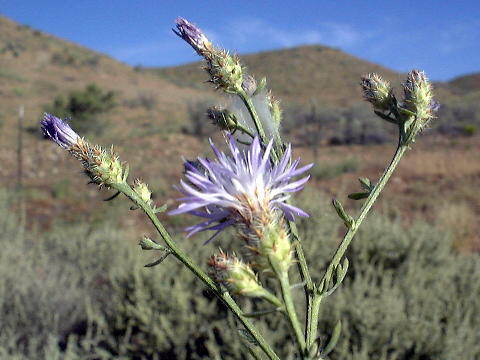 Diffuse Knapweed - May 5, 2004 Jeff Schalau, County Director, Agent, Agriculture & Natural Resources Arizona Cooperative Extension, Yavapai County The scant spring rains have increased growth of cool season weeds- including invasive, noxious weed species. Noxious weeds have the ability to invade undisturbed ecosystems and displace native plant species. By definition, noxious weeds are plants specified by law or regulation to be particularly undesirable, destructive and difficult to control. In the Verde Valley area, some of these are diffuse knapweed, Russian knapweed, Dalmatian toadflax, Scotch thistle, yellow starthistle, and Malta starthistle.  Diffuse knapweed (Centaurea diffusa) is one species that I have not written about previously. It is native to disturbed areas and seashores from southern Europe to north-central Ukraine. In Europe, it is generally is found on dry, light, porous soils. Diffuse knapweed will not tolerate flooding or shade and thrives in the semiarid west (generally in 9- to 16-inch precipitation zones). Environmental disturbance (e.g., overgrazed pastures or rangeland, roadsides, rights-of-way, gravel piles, etc.) promotes its invasion. In northern Arizona, diffuse knapweed has taken hold in the in Flagstaff and Sedona areas. In Flagstaff, it is all the east side of town in disturbed areas. In Sedona, you may see diffuse knapweed in the Seven Canyons/Upper Dry Creek area, the Palatakai Ruin site, or on your property if you are near one of these areas.
Diffuse knapweed (Centaurea diffusa) is one species that I have not written about previously. It is native to disturbed areas and seashores from southern Europe to north-central Ukraine. In Europe, it is generally is found on dry, light, porous soils. Diffuse knapweed will not tolerate flooding or shade and thrives in the semiarid west (generally in 9- to 16-inch precipitation zones). Environmental disturbance (e.g., overgrazed pastures or rangeland, roadsides, rights-of-way, gravel piles, etc.) promotes its invasion. In northern Arizona, diffuse knapweed has taken hold in the in Flagstaff and Sedona areas. In Flagstaff, it is all the east side of town in disturbed areas. In Sedona, you may see diffuse knapweed in the Seven Canyons/Upper Dry Creek area, the Palatakai Ruin site, or on your property if you are near one of these areas.Diffuse knapweed can be a short-lived perennial, a biennial, or occasionally an annual and reproduces and spreads from seed. Young plants start out as a rosette with finely divided leaves (somewhat like a dandelion). Later in the growing season, it develops a single shoot (stem), 1 to 2 feet tall, that branches toward the top. Grazed plants may produce multiple stems. Leaves become smaller toward the top of the shoot and have smooth margins. Diffuse knapweed produces flowers in early- to mid-summer with many solitary flowering heads occur on shoot tips. Flowers are about 1/8 inch in diameter and 1/2 to 2/3 inch long. They resemble small thistle flowers that are white but may be purplish. The have pointy bracts on the green portion at the base of the flower. These bracts (called the involucre) are divided like teeth on a comb and tipped with a slender spine that makes them sharp to the touch. Sometimes the bracts are dark-tipped or spotted like spotted knapweed. Diffuse knapweed can be controlled in small areas by hand grubbing. You should always wear heavy gloves because it can cause severe skin irritation. It is best to get the rosettes before they flower. However, you can successfully hand grub more mature plants. Just be sure to get as much of the taproot as possible as it has adventitious buds that will resprout. If flowers have matured and seed is present, then all plants should be double bagged in heavy duty plastic bags and taken directly to the landfill for burial. Herbicides are available that will control broadleaf plants (including diffuse knapweed) without harming desirable grasses. The most effective herbicides are restricted use (only available to certified applicators) and should only be used on large areas. Any control method should be accompanied by planting desirable perennial grasses to provide some competition. Insects are also being evaluated that may effectively control diffuse knapweed. Diffuse knapweed is also known as tumble knapweed because it will often snap off at ground level after it dries out. After this, it can be blown by wind and seed is then dispersed across the landscape. For more information and photos of diffuse knapweed, see Weeds of the West: a book published by the Western Society of Weed Science or visit the following web site: www.ext.colostate.edu/pubs/natres/03110.html. The University of Arizona Cooperative Extension has publications and information on gardening and pest control. If you have other gardening questions, call the Master Gardener line in the Cottonwood office at 646-9113 ext. 14 or E-mail us at mgardener@verdeonline.com and be sure to include your address and phone number. Find past Backyard Gardener columns or submit column ideas at the Backyard Gardener web site: http://cals.arizona.edu/yavapai/anr/hort/byg/. |